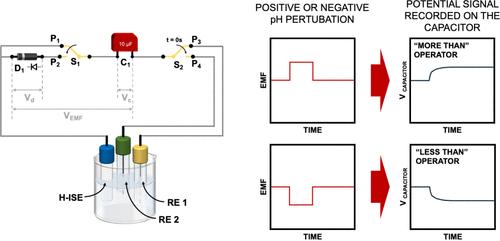带相关操作功能的自供电电位计传感器可捕捉浓度偏移
IF 6.7
1区 化学
Q1 CHEMISTRY, ANALYTICAL
引用次数: 0
摘要
自供电电位传感器无需外部电源即可自发响应目标物种的活性变化。这里介绍的自供电电位计传感方法可通过电容器和二极管的组合存储传感器读出之前发生的浓度扰动。传感器电路中有两个通道,分别称为 "大于 "和 "小于 "操作器,用作存储模块,分别记录正负浓度偏移。每个通道都由一对电容二极管构成,其中每个二极管都与一个电容反向连接,以防止不必要的电容放电。通过这种设计,只有与二极管极性一致的电位变化才能通过并存储在电容器中。该原理的一个局限性是,如果二极管两端的电压在接近平衡值时随着时间的推移而减小,那么二极管的电导率就会非常小。为解决这一问题,可通过从最初的 Ag/AgCl 参比电极 (RE) 切换到 Zn/Zn2+ 元件,将正向电压提高约 1 V。该装置可用于以半定量方式监测在信号读出之前的时间内是否发生了浓度偏移。该方法还能区分不同持续时间(20、40、60 分钟)的 pH 值偏移。例如,在河水样本中成功区分了持续时间为 20 分钟的四种不同 pH 值偏移,相对于没有 pH 值扰动的情况,其振幅为 1 到 4 个 pH 单位。本文章由计算机程序翻译,如有差异,请以英文原文为准。

Self-Powered Potentiometric Sensor with Relational Operation Function to Capture Concentration Excursions
Self-powered potentiometric sensors spontaneously respond to activity changes of target species without the need for an external power source. Here, a self-powered potentiometric sensing approach is described that may store concentration perturbations that occur before the sensor readout through a combination of capacitors and diodes. Two channels, termed “more than” and “less than” operators, are utilized as memory modules in the sensor circuit to record positive and negative concentration excursions, respectively. Each channel is constructed with a capacitor-diode pair in which each diode is connected to a capacitor in the opposite direction to prevent unwanted capacitor discharge. With this design, only potential variations that agree with the polarity of the diode may pass and be stored in the capacitor. A limitation of the principle is that the conductivity of the diode is very small if the voltage across it diminishes over time as it approaches the equilibrium value. To address this, the forward voltage is increased by about 1 V by switching from an initial Ag/AgCl reference electrode (RE) to a Zn/Zn2+ element. The device may be used to monitor whether a concentration excursion has occurred in the time leading up to the signal readout in a semiquantitative manner. The approach also differentiates pH excursions of different durations (20, 40, 60 min). As an example, four different pH excursions of 20 min duration were successfully distinguished in river water samples with amplitudes of 1 to 4 pH units relative to the case without pH perturbation.
求助全文
通过发布文献求助,成功后即可免费获取论文全文。
去求助
来源期刊

Analytical Chemistry
化学-分析化学
CiteScore
12.10
自引率
12.20%
发文量
1949
审稿时长
1.4 months
期刊介绍:
Analytical Chemistry, a peer-reviewed research journal, focuses on disseminating new and original knowledge across all branches of analytical chemistry. Fundamental articles may explore general principles of chemical measurement science and need not directly address existing or potential analytical methodology. They can be entirely theoretical or report experimental results. Contributions may cover various phases of analytical operations, including sampling, bioanalysis, electrochemistry, mass spectrometry, microscale and nanoscale systems, environmental analysis, separations, spectroscopy, chemical reactions and selectivity, instrumentation, imaging, surface analysis, and data processing. Papers discussing known analytical methods should present a significant, original application of the method, a notable improvement, or results on an important analyte.
 求助内容:
求助内容: 应助结果提醒方式:
应助结果提醒方式:


